
Masonic, Occult and Esoteric Online Library
Fictitious and Symbolic Creatures in Art
By John Vinycomb
Chimerical Creatures of the Dragon and Serpent kind - The Wyvern
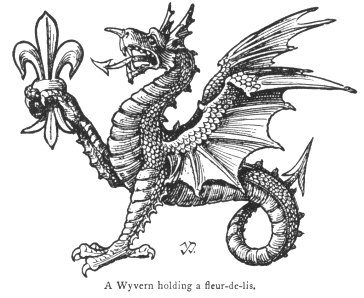
(Saxon, Wivere, a serpent) said to represent a flying serpent, an imaginary creature resembling the dragon, but having only two legs, which are like an eagle's, and a serpent-like tail, barbed, sometimes represented nowed after the manner of serpents. It is figured on one of the 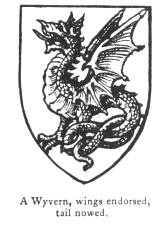
standards in the Bayeux tapestry (see Dragon, p. 86). It is erroneously termed a dragon by some writers, though perhaps they may both be classed together. Old heralds say of these imaginary monsters that they are emblems of pestilence, and are represented as strong and fierce animals covered with invulnerable mail, and fitly typify viciousness and 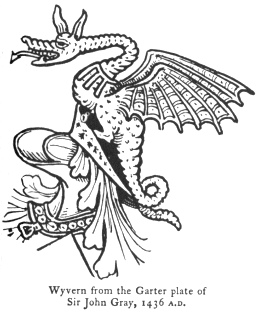
envy. In armory they are properly applied to tyranny or the overthrow of a vicious enemy.
Occasionally a wyvern is borne with the tail nowed and without wings.
Lindworm.—It is not usual to say a wyvern "without wings" or "without legs," but sans wings or sans legs, as the case may be. A dragon or wyvern sans wings is termed a lindworm. (See page 80.)
Argent, a wyvern, wings endorsed gules, are the arms 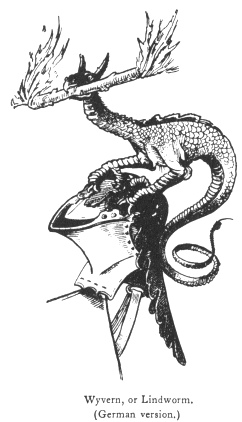
of Drake, of Ashe, Devon (Bart.), 1600.
The town of Leicester has for crest a wyvern, wings expanded, sans legs, strewed with wounds, gules.
Argent on a bend sable, between two lions rampant of the last, a wyvern volant in bend of the field, langued gules, Ruddings.
Two wyverns, wings endorsed and emitting flames, are the supporters of Viscount Arbuthnot.
The arms of the King of Portugal are supported by two wyverns erect on their tails or, each holding a banner, the crest is a demi-wyvern out of a ducal coronet.
Guivre.—The wyvern or serpent in the arms of the Visconti, Lords of Milan, argent a guivre d’azure couronnée d’or, issante de gules (Guivre is represented as a serpent or wingless dragon sans feet, with a child's body issuing from its mouth), is said to commemorate the victory of a lord of that house over a fiery dragon or guivre which inhabited a cavern under the church of St. Denis in that place. "It is hardly possible," says Miss Millington, "not to think that the story of the dragon as well as its adoption in the coat-of-arms
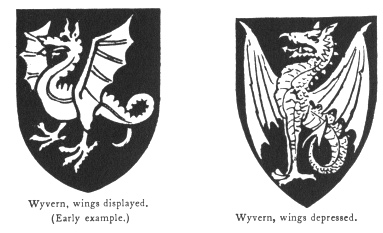
bears allusion rather to the dragon of paganism, expelled from the city, as it might seem, by the church built upon the site of the cave, in which too, by the rite of Holy Baptism, children especially were delivered from the power of Satan. Indeed, the innumerable legends of saints who have fought and overcome dragons sufficiently prove the symbolic light in which that creature was anciently viewed." (See also Serpent Biscia, p. 117.)
